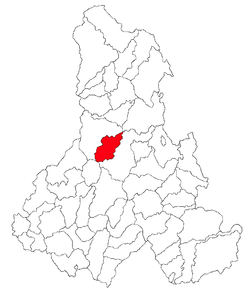Ciumani
| Ciumani Gyergyócsomafalva | |
|---|---|
| Commune | |
 Location of Ciumani | |
 Ciumani Location of Ciumani | |
| Coordinates: 46°41′0″N 25°31′0″E / 46.68333°N 25.51667°ECoordinates: 46°41′0″N 25°31′0″E / 46.68333°N 25.51667°E | |
| Country |
|
| County | Harghita County |
| Status | Commune |
| Government | |
| • Mayor | József Barabás (Independent) |
| Area | |
| • Total | 96.83 km2 (37.39 sq mi) |
| Population (2011) | |
| • Total | 4,334 |
| • Density | 46.4/km2 (120/sq mi) |
| Ethnicity[1] | |
| • Hungarians | 99.67% |
| • Romanians | 0.3% |
| Religion | |
| • Roman-Catholic | 97.95% |
| • Reformed | 1.33% |
| Time zone | EET (UTC+2) |
| • Summer (DST) | EEST (UTC+3) |
| Postal Code | 537050 |
| Area code(s) | +40 266 |
| Website | www.csomafalva.ro |
Ciumani (Hungarian: Gyergyócsomafalva, Hungarian pronunciation: [ˈɟɛrɟoːtʃomɒfɒlvɒ]) is a commune in Harghita County, Romania. It lies in the Székely Land, an ethno-cultural region in eastern Transylvania. It is composed of a single village, Ciumani.
Governance
It belonged first to the Székely seat of Gyergyószék, which was subsequently absorbed into Csíkszék, then, from 1876 until 1918, to Csík County in the Kingdom of Hungary. After World War I, by the terms of the Treaty of Trianon of 1920, it became part of Romania. As a result of the Second Vienna Award, it belonged to Hungary again between 1940 and 1944. After World War II, it came under Romanian administration and became part of Romania in 1947. Between 1952 and 1960, it formed part of the Hungarian Autonomous Province, then, of the Mureş-Hungarian Autonomous Province until it was abolished in 1968. Since then, the commune has been part of Harghita County.
Demographics
The commune has an absolute Székely (Hungarian) majority. According to the 2011 census it has a population of 4,334 of which 99.68% or 4,320 are Hungarian.
Twin towns - sister cities
 Baktalórántháza, Hungary
Baktalórántháza, Hungary Dány, Hungary
Dány, Hungary Erdőbénye, Hungary
Erdőbénye, Hungary Heves, Hungary
Heves, Hungary Ráckeve, Hungary
Ráckeve, Hungary Nenince, Slovakia
Nenince, Slovakia Totovo Selo, Serbia
Totovo Selo, Serbia Kanjiža, Serbia
Kanjiža, Serbia
References
- ↑ Romanian Census 2002; retrieved on May 4, 2010
